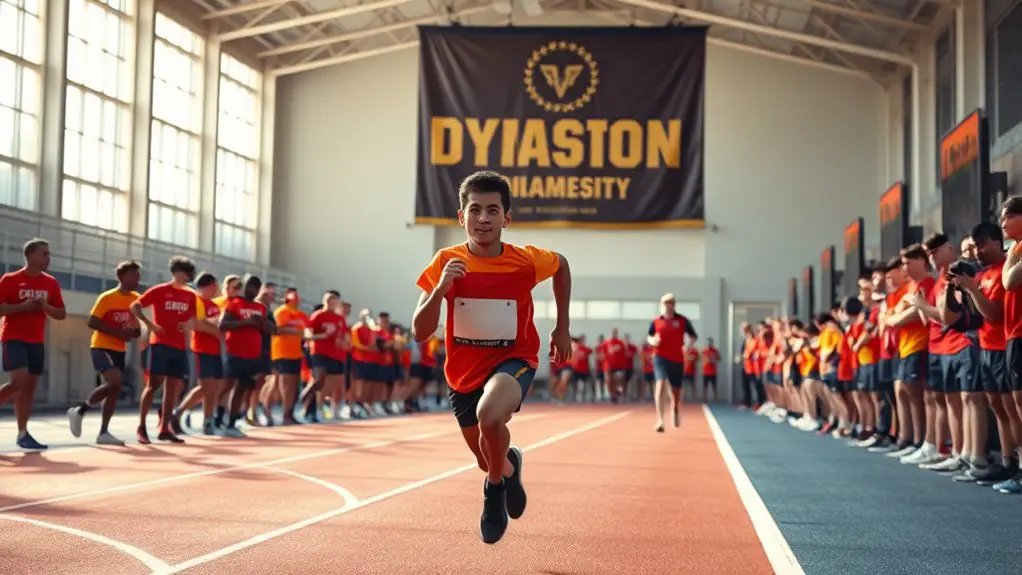Sports dynasties like the New England Patriots and the Chicago Bulls transform training culture by embedding a winning mindset and fostering innovation. They prioritize teamwork and accountability, pushing athletes to excel. This environment encourages the adoption of advanced training methods and emphasizes personal growth within a collective framework. You'll see how these influential teams shape individual athlete development and promote a culture that inspires future generations of competitors. There's much more to explore about this dynamic influence.
Defining a Sports Dynasty: Characteristics and Examples
When you think about a sports dynasty, what often comes to mind are teams that consistently dominate their leagues, showcasing a blend of talent, strategy, and resilience. Key dynasty characteristics include sustained success over multiple seasons, a strong roster of skilled players, and a winning culture that becomes ingrained in the organization. Historical examples like the New York Yankees, with their 27 championships, and the Chicago Bulls, led by Michael Jordan, illustrate how these teams leave a lasting impact on their respective sports.
These dynasties don't just win; they redefine expectations and inspire future generations. Their ability to adapt, innovate, and maintain high performance under pressure is what sets them apart. To achieve such greatness, they cultivate an environment where each member feels empowered, fostering a sense of unity and purpose. Ultimately, understanding these characteristics can fuel your passion for sports and inspire your own pursuit of excellence. Intrinsic motivation plays a crucial role in maintaining the drive and commitment necessary for such sustained success.
The Role of Leadership in Shaping Training Culture
When it comes to shaping a training culture, leadership plays a pivotal role in integrating vision and values. You'll see how effective communication strategies can foster a positive environment, while accountability and responsibility are essential for team growth. Let's explore how these elements come together to create a winning culture. Additionally, mental toughness is crucial for athletes to maintain composure and determination in the face of challenges.
Vision and Values Integration
While effective leadership often sets the tone for a team's success, it's the integration of vision and values that truly shapes a training culture. When you align your team's vision and reinforce core values, you create an environment where everyone thrives. Here are four key aspects to reflect on:
- Shared Goals: Guarantee everyone understands and contributes to the team's vision alignment.
- Encouragement: Foster a culture of values reinforcement, where positive behavior is recognized.
- Empowerment: Give team members the freedom to express ideas, enhancing creativity and collaboration.
- Consistent Messaging: Leaders should consistently communicate the vision and values, making them a part of daily practice.
Through these steps, you'll cultivate a training culture that resonates with the essence of freedom and teamwork.
Effective Communication Strategies
Effective communication is essential for leaders who want to shape a thriving training culture. By adopting diverse communication styles, you can better connect with your athletes and staff, fostering an environment where everyone feels valued. Encourage open dialogue and create feedback loops that allow for honest discussions about performance and expectations. This not only empowers individuals but also cultivates a sense of ownership in the training process. When you actively listen and respond to concerns, you demonstrate that every voice matters, enhancing trust and collaboration. Remember, effective communication isn't just about talking; it's about creating a space where ideas flow freely, enabling your team to reach their full potential. Embrace this approach, and watch your training culture flourish.
Accountability and Responsibility Roles
Open communication lays the groundwork for accountability and responsibility within a training culture. When you foster transparency, you empower individuals to take ownership of their roles. Peer leadership becomes essential, as teammates encourage one another to uphold standards and challenge each other to improve. Here are four key elements to build effective accountability frameworks:
- Clear Expectations: Define roles and responsibilities to eliminate confusion.
- Regular Check-Ins: Schedule consistent discussions to assess progress and address concerns.
- Feedback Loops: Create a culture where constructive criticism is welcomed and valued.
- Celebrate Successes: Acknowledge achievements to reinforce positive behaviors and motivate the team.
Innovations in Training Methodologies Inspired by Dynasties
As sports dynasties have thrived through generations, they've also sparked groundbreaking innovations in training methodologies that elevate performance. You've likely noticed how these teams adopt cutting-edge training technology and performance analytics to push boundaries. By leveraging data, they can tailor workouts that fit individual strengths and weaknesses, maximizing each athlete's potential.
Imagine being part of a system driven by constant improvement, where every sprint, lift, or practice drill is meticulously analyzed. These dynasties have pioneered techniques like video analysis and biomechanical assessments, allowing you to refine your skills with precision. Moreover, the sharing of best practices within these teams creates an environment where creativity flourishes. You're not just following a routine; you're part of a dynamic approach that adapts and evolves, ensuring you have the freedom to explore new methods. Embracing these innovations can redefine what you thought was possible in your training journey. Additionally, real-time analytics plays a crucial role in enhancing performance and injury management, further supporting athletes in their training endeavors.
The Influence of Team Culture on Individual Athlete Development
Team culture plays an essential role in shaping your development as an athlete. Values like ethics and accountability foster a supportive environment where you can thrive, while strong leadership and mentorship guide your growth. When everyone shares a common goal, it elevates not just individual performance but the entire team's success. Additionally, fostering a growth mindset within the team encourages athletes to embrace challenges and learn from setbacks, ultimately enhancing their performance.
Team Values and Ethics
Unity in values and ethics often shapes the foundation of a successful sports dynasty, influencing how individual athletes develop both on and off the field. When you embrace a strong team culture, it fosters team cohesion and guides ethical decision-making. This allows you to thrive in your sport while growing as an individual. Here are four key aspects to reflect upon:
- Shared Goals: Aligning personal ambitions with team objectives enhances motivation.
- Respect: Valuing each teammate's contributions builds trust and collaboration.
- Integrity: Upholding ethical standards creates a sense of accountability.
- Inclusivity: Encouraging diverse perspectives strengthens team dynamics.
Peer Accountability and Support
When athletes feel supported by their peers, they're more likely to thrive in their development, both personally and professionally. This sense of camaraderie fosters an environment where peer motivation flourishes, driving each individual to push their limits. When everyone shares common goals, accountability naturally emerges; you're not just working for yourself, but for your teammates too. This collective mindset creates a dynamic where failures are seen as learning opportunities rather than setbacks. You'll find that encouragement is abundant, and constructive feedback helps sharpen skills. In such a culture, athletes can express their individuality while still feeling deeply connected to their team. Ultimately, this balance promotes growth and elevates performance, making everyone stronger together.
Leadership and Mentorship Roles
A strong culture of peer accountability often lays the groundwork for effective leadership and mentorship within a team. When athletes feel supported and responsible for one another, it fosters an environment ripe for growth. Here's how different leadership styles and mentorship strategies can enhance individual athlete development:
- Empowerment: Leaders encourage athletes to take ownership of their training and decisions.
- Open Communication: Mentors create safe spaces for sharing challenges and successes.
- Role Modeling: Experienced athletes showcase the behaviors and attitudes that inspire others.
- Tailored Guidance: Mentors adapt their strategies to fit each athlete's unique needs and goals.
The Psychological Aspects of Training in a Dynasty Environment
Training in a dynasty environment can be both exhilarating and intimidating, as the pressure to maintain excellence often weighs heavily on athletes. You'll need to cultivate mental resilience to push through challenges, fostering a competitive mindset that drives you to excel. Emotional intelligence becomes vital in maneuvering team dynamics, ensuring strong team synergy under performance pressure.
Implementing effective stress management techniques can help you stay centered, while focus strategies enhance your training sessions. Embracing a growth mindset allows you to view setbacks as opportunities for improvement, fostering self-discipline as you commit to your goals. Using motivation techniques tailored to your unique personality can keep you inspired, even on tough days. In such a high-stakes environment, it's imperative to balance your pursuit of success with self-care, ensuring you remain mentally strong and prepared for the challenges ahead. This blend of psychological tools can help you thrive amidst the demands of a dynasty. Additionally, incorporating mindfulness techniques can aid in managing anxiety and enhance your overall performance.
Lessons for Aspiring Athletes: Emulating the Greats
To emulate the greats in sports, you need to study their journeys and understand the habits that fueled their success. By adopting the right mindset and strategies, you can pave your path to greatness. Here are some key lessons to reflect upon:
- Role Models: Identify athletes who embody the competitive spirit and resilience training you aspire to achieve.
- Success Habits: Adopt daily routines that focus on goal setting and performance analysis; consistency is key.
- Teamwork Dynamics: Understand the importance of collaboration and how it contributes to legacy building within a team.
- Strategic Planning: Develop a clear plan that aligns with your aspirations, ensuring you're prepared for any challenge. Additionally, surrounding yourself with supportive people can significantly enhance your growth and motivation.
Emulating these principles can help you cultivate an athlete mindset, pushing you toward excellence while honoring the legends who came before you. Remember, your journey is yours to shape!
Frequently Asked Questions
How Do Sports Dynasties Influence Youth Sports Programs?
Sports dynasties can really shape youth sports programs in significant ways. When you see a successful team, it inspires you and others to get involved, boosting youth engagement. Plus, these dynasties often attract funding and resources, enhancing training facilities and coaching quality. You'll notice that aspiring young athletes benefit from better training resources, which can help them develop their skills and passion for the sport, leading to a more vibrant sports community.
What Role Do Fans Play in a Dynasty's Training Culture?
Fans play an essential role in shaping a dynasty's training culture, driving fan engagement and fostering community support. When you cheer for your team, you're not just a spectator; your passion influences players' motivation and dedication. This connection creates an environment where athletes feel accountable to their supporters, pushing them to excel. In turn, the community rallies behind youth programs, inspiring the next generation to pursue greatness and embrace the spirit of teamwork.
Are There Negative Effects of Dynasties on Individual Athlete Performance?
When you're in the spotlight of a dynasty, it's like walking a tightrope; one misstep can lead to a fall. The pressure management can become overwhelming, pushing you towards athlete burnout. You might feel trapped under expectations, which can stifle your creativity and passion for the sport. Instead of thriving, you may find yourself merely surviving, longing for the freedom to express your true potential without the weight of a dynasty's legacy on your shoulders.
How Do Dynasties Impact Coaching Styles in Other Teams?
Dynasties can really shift how coaches approach their philosophy and competitive strategies. You might notice that when one team dominates, others often adapt by trying to emulate their success. This can lead to more innovative tactics or, conversely, a reliance on outdated methods. Coaches may feel pressured to conform, stifling creativity. Ultimately, you'll see teams either rise to the challenge or struggle to find their unique identity in the shadow of a dynasty.
What Are the Economic Implications of Sports Dynasties on Local Communities?
What if a team's success could transform your neighborhood? Sports dynasties often lead to local business growth, as fans flock to games, fueling restaurants and shops. You might notice community pride swelling, uniting people around a common love. Yet, there's a flip side; while some thrive, others might feel left behind. The economic implications can be complex, but the vibrant energy of a winning team often breathes life into local communities.




